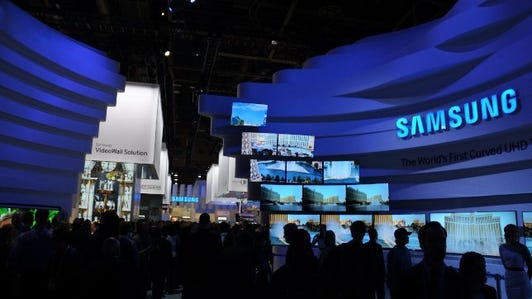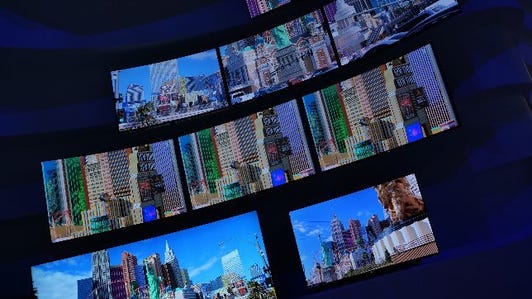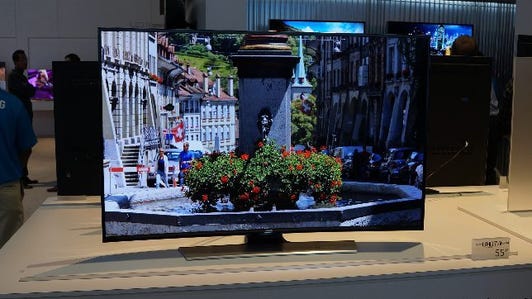LAS VEGAS — Samsung is usually ahead of the curve.
The company enjoys a comfortable domination of worldwide TV market share and profitability, powered by its trendsetting designs and futuristic technologies. It popularized the first really thin LED LCDs, pushed TV app stores before anyone else, brought hairline bezels into the mainstream, and was first with voice and gesture control and real modular hardware upgrades.
Samsung: televisions of 2014 CES (pictures)






Now it’s the first to deliver curved TVs in a serious way, debuting two series of mainstream LED LCD models, one with 4K resolution and one with standard 1080p, at CES 2014.
The first curved flat-panel TVs — let’s all just agree to ignore that oxymoron for the present — appeared last year. They included a pair of extremely expensive OLEDs from LG and Samsung, as well as the first curved LED LCD, Sony’s KDL-65S990A. At CES 2014 LG introduced a few curved sets, but they were mainly OLEDs and none will be remotely affordable.
Are these screens another home-run innovation or too much of a curve ball to score with TV buyers? Only the market can decide, but while we wait around for that to happen, allow me to spitball a bit.
Samsung’s 55-inch OLED: I wished it was flat
If you’ve read my CES 2014 TVs recap — and you’d darn well better, bub — you’d know my answer to the headline’s question isn’t necessarily “Yes, curved TVs are a gimmick that makes 3D TV look like a stroke of marketing genius.” I like to actually watch a TV technology for a while before I denounce it completely.


That said, curved TV isn’t off to the best start in my book. Here’s what I thought after a few hours with Samsung’s curved OLED — my only significant time watching a curved TV.
For a videophile with money to burn who doesn’t mind a relatively small 55-inch size, the curved screen is a major fly in the ointment. It was definitely noticeable from the sweet spot at my seating distance of about 7 feet. The corners seemed wider than the middle, creating a subtle trapezoid effect that I found distracting compared with the flatter shape of the traditional screen. The horizontal edges bowed wider toward the edges too, creating a subtle “U” along the top edge and an inverted one along the bottom.
Another strange effect was that the roundness of the curve changed as I sat higher or lower relative to the screen. From my standard seating position, in an office chair watching the TV set atop a 2.5-foot stand, the bottom of the screen bent more noticeably than the top. From off-angle the distortions became even less equal.
The TV also angles back on its stand by default. Samsung’s rep told me part of the reason was to comply with standards designed to prevent it from falling over. The visual effect, however, is of even more distortion; from my seat the vertical edges of the screen narrow toward the top. Combined with any distortions in the film — “I Am Legend” uses a lot of fish-eye lens shots, for example — the total started to seem Escheresque.
The curve wasn’t all bad. On shots with greater depth of field, like the cityscapes at the beginning of “I Am Legend,” I thought I experienced a slightly greater sense of depth and immersion as I looked out into the distance in the middle of the screen.
I also noticed that reflections were both more muted, again thanks to an excellent antireflective screen, and much less likely to be caught in the curved screen of the OLED than in the flat screen of the plasma. That’s one important, unexpected benefit of the curve.
I can imagine the curve is something you can get used to, just like any artifact, but if I was that videophile with infinite funds, I’d probably still wait for a flat one.
I’ve never been dissatisfied with a flat screen, and while the curve could help impart some extra feeling of depth and/or help to reduce reflections, the distorting tradeoffs weren’t worth those benefits in my brief viewing session.
A TV isn’t an IMAX screen
The premise of the curved IMAX screens makes sense, in that the huge image surrounds and almost envelops you. That analogy was the initial justification Samsung and LG used to market the curve of their OLEDs.
But as Geoff Morrison pointed out, that argument doesn’t hold as much water with normal TV screen sizes and viewing distances.
With really large screens, one of the biggest advantages is being able to “focus” more light toward the audience. Another is reducing optical distortions when using certain projection lenses. There’s also a potential “naturalness” to an image that has every part equidistant to your eyeballs. But perhaps the most notable benefit is the ability to fill a massive percentage of a viewer’s field of view. Sitting in the right seat, you could have the image practically wrapped around you.
To get the benefit of a wraparound image, or even the benefit of a more natural image that has every part equidistant from your eye, you need to be sitting in a pretty specific place. With a theater screen, that place is an area big enough in which a lot of people can sit. Sure, people off to the sides aren’t getting the best effect (if any), but the folks in the middle are. With a smaller curved screen, that sweet spot is a lot smaller.
[A curved screen] effectively requires the owner to sit at a rather precise distance from the screen. Too close or too far, and the curve loses its major benefits. And let’s not forget, this is for one viewer. With several people on the couch, all the claimed benefits are lost.
Samsung’s mainstream curved sets range from 48 to 78 inches diagonal. Yes, you’ve probably read breathless reports about the 105-inch pituitary freak, but that’s likely a $60,000 TV. Samsung says all of its mainstream curved TVs target the same viewing distance, 10 to 13 feet away, depending on screen size. From those distances, even a 78-inch screen can’t provide the feeling of surround vision that you get from IMAX.
The jerk effect
Morrison touched on another point that I’m curious to explore when I review a curved TV: how does it look from seating positions that aren’t the sweet spot directly in the middle of the screen? As my colleague Ty Pendlebury has said, you’d have to be a real jerk to buy a curved TV, because you’d be the one person in the family who’d enjoy its supposed benefits.
If my experience with Samsung’s OLED is any indication, viewers to either side of the sweet spot will experience an unequally distorted view. It’s the same with a flat TV, of course, where one edge appears larger than the other, but when you add a curve to that effect I can’t help but think the distortions would get worse.
Another potential issue is that curved LED LCDs, the technology Samsung uses for all of its mainstream curved sets, might suffer even worse off-angle viewing issues than their flat brothers, washing out faster on the near side of the screen. The same goes for uniformity: I imagine it’s more difficult to make a curved screen maintain uniform brightness and color across its surface.


How much more will curved cost?
Samsung hasn’t announced pricing on its two lines of curved TVs, but I’m betting they won’t be cheap. The best comparable set we have now, Sony’s 65-inch KDL-65S990A, costs $4,000. That’s 60 percent more than its flat 1080p equivalent, which costs $2,500, and the same as the current flat 4K model.
Even if Samsung manages to shave the cost of curve down to 30 percent or 40 percent more than flat, I expect its curved 1080p TVs to cost more than the flat 4K ones — in part because 4K will get much cheaper in 2014.
And that’s a great reason for Samsung to try to get people to buy a curved TV. The cost of 4K resolution is already sinking like a stone — Vizio’s 50-inch P series will cost just $1,000 — so curved TVs provide an opportunity to charge more and maintain profit margins.
I’ll be very interested to see what pricing Samsung announces for its curved TVs. Official word is expected sometime in March.
Do I have to get used to it?
I still feel like perhaps spending a lot of time watching a curved TV, I might get to appreciate what it does to the picture. That’s why they play the games, right? But as of right now, I find it tough to imagine that I’d willingly trade a flat TV for the same curved one. I’ll know for sure when I can review one in person, and until then I won’t use the G-word. Much.


Now playing:
Watch this:
Reasons not to buy a curved TV
2:58




